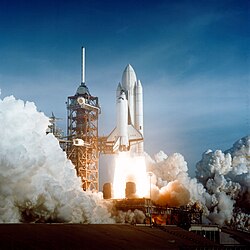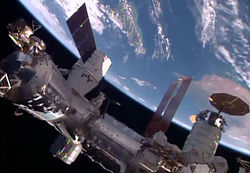Soyuz 7K-ST No. 16L (sometimes known as
Soyuz T-10a or
T-10-1) was an unsuccessful Soyuz mission intended to visit the
Salyut 7 space station, which was occupied by the
Soyuz T-9 crew.
It was set to launch atop a Soyuz-U rocket on September 26, 1983. However, prior to launch, the rocket caught fire on its launch pad at Site 1/5, Baikonur Cosmodrome. The launch escape system of the Soyuz spacecraft fired two seconds before the launch vehicle exploded, saving the crew of commander Vladimir G. Titov and flight engineer Gennadi Strekalov. It is so far the only case in which a launch escape system has been fired with a crew aboard.
The mission was a visiting expedition to Salyut 7. The crew was scheduled to return in Soyuz T-9, leaving Soyuz T-10 for the crew on the space station to return in later. The failure briefly led to speculation in the West that the crew of Soyuz T-9 may be stranded on the space station, but this was never the case. That crew would return to Earth as normal on November 23, 1983, aboard Soyuz T-9.

Sergey Pavlovich Korolyov (December 30, 1906 - January 14, 1966) was a Soviet rocket engineer and is widely regarded as the founder of the Soviet space program. In July 1932, Korolev was appointed chief of Jet Propulsion Research Group, GIRD, one of the earliest state-sponsored centers for rocket development in the USSR. In 1933, the group was reorganized into the Jet Propulsion Research Institute, RNII, where Korolyov worked as Deputy Chief of the institute. At RNII, Korolyov led the development of cruise missiles and of a manned rocket-powered glider. He also participated in the development of the Tu-2 bomber, a major aircraft of the Soviet Air Force during World War II. In 1945, he was commissioned into the Red Army, with a rank of colonel and, along with other rocket experts, he was flown to Germany to gather information on the German V-2 rocket. Korolyov worked on the R-1 missile which was a replica of the German V-2 ballistic missile. In 1947 the NII-88 group under Korolyov began working on more advanced designs, with improvements in range and throw weight. This led to the R-2 and R-3 ballistic missiles and finally the R-7 ICBM. He successfully convinced the Soviet leaders to fund the Sputnik program. The actual development of Sputnik was performed in less than a month. Finally on 4 October 1957, launched on a rocket that had only successfully launched once, the satellite was placed in orbit. This was followed by the launch of Sputnik 2 and 3. Korolyov's planning for a manned mission had begun back in 1958, when design studies were made on the future Vostok spacecraft. After the success of Vostok, Korolyov planned to move forward with Soyuz spacecraft that would be able to dock with other craft in orbit and exchange crews. For the moon race, Korolyov's staff designed the immense N1 rocket. He also had in work the design for the Soyuz manned spacecraft, as well as the Luna vehicles that would soft land on the Moon and unmanned missions to Mars and Venus. But, unexpectedly, he was to die before he could see his various plans brought to fruition. (Full article...)





























